Robert Pearce FLOCKART
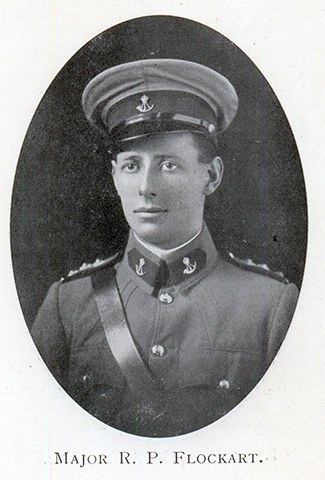
Robert Flockart was born on 14 November 1886 in Ballarat, Victoria. His parents were Robert Munday and Henrietta (née Pearce) Flockart. He attended Scotch from 1901 to 1902. He was in Cadets.
Robert was a clerk when he enlisted on 25 August 1914 at Melbourne. He served in the 5th Battalion with the rank of Major.
Robert died on 15 July 1915 at sea (Hospital Ship Gascon) from wounds sustained at Gallipoli. He was 28 years of age.
Service record
Before the war ‘Bert’ Flockart had served in the 51st Battalion of the Citizen Military Forces. He was made Captain on enlistment. He participated with the 5th Battalion in the second wave of the landing at Gallipoli. He was wounded in the face, officially on 26 April 1915 but according to a letter dated 28 April to his mother it was on 25 April. He was transported to hospital. He wrote: ‘I am at sea again, but on the way back to Alexandria; we have had our first fight and I am thankful to say we were successful as you of course know by the papers, and I am going back to get some minor repairs to my face as I caught a schrapnel bullet in the cheek, which is still in there and knocked out a few of my back teeth.’ (see document below). He continued: ‘I am thankful to say that it was not worse – Only today I found that the bullet was still there, I thought that my jaw was only swollen as a result, but the swelling has gone down a bit and I can feel the wretched thing there quite well and it will have to be taken out.’ In the same letter he mentioned the death on 25 April of his fellow 5th Battalion officer and good friend, Captain Erle Fethers (formerly of Malvern Grammar).
Charles Bean noted in the Australian official history that Flockart led his company on to a vital position called Johnston’s Jolly. There, when he found the body of Fethers, his ‘bosom companion’, he ‘dropped down beside it and covered his friend’s face with his cap.’ Flockart was by that stage the only unwounded company commander of the 5th Battalion in that location and organised his men and strays from other battalions to hold the Jolly.
Bert said of the Landing that although the newspapers would exaggerate, ‘there is no doubt that it was a good show and for us all to be thrown into such a big important affair right off the boats was no mean achievement, especially as we couldn’t land artillery’. He said of the troops that ‘the behaviour and discipline of the men was beyond reproach and beyond my wildest expectations.’ Of conditions at the Landing, he wrote: ‘The warships opened fire and so the show commenced and from then onward it was as hot as it possibly could be. It simply rained schrapnel, which was the most deadly of all and I got my ration about 11 oclock…so I tied it up and hadn’t a chance to go back till about 8 pm when I met the Colonel [commanding the 5th Battalion] and things seemed quieter – I thought it was only a cut intended to come back to where we were digging in for the night’ However, on asking for it to be dressed he was told that he must go to hospital, so was sent to a hospital ship. His sense of duty was apparent in the comment: 'I felt an awful cad leaving my company with [Captain] Luxton – I don’t know how many are alive or anything about them and it is a great disappointment to have to leave them even for a few days – as I hope to soon get back again.’ He said of a confrontation with a Turk: ‘I was kept busy all day but on one occasion I managed to have poop [?] with my revolver at a Turk’s ugly visage…I saw the bird having a pot at me over a bush – so I had one at him, but don’t know whether I got a score or not – it is so difficult to see in the scrub.’
After treatment in Egypt, he returned to Gallipoli by ship, rejoining his battalion on 17 May with the rank of Major. On 25 May he wrote to his mother: ‘It is awfully good to get letters here.[There is]so much tumult going on – It is an incessant state of firing, especially at night.’ This young Methodist wrote in the same letter that ‘On Sunday morning I went to Communion outside a dugout and there was rifle and gun fire going on all the time.’ A truce on 24 May allowed the Turks to bury their dead and for Bert and others to take a swim and a walk: ‘It was such a relief, not a shot fired and everything as quiet as possible…It was like a holiday.’ He said he was looking forward to a life where he could walk about quietly ‘without running from cover to cover and lying down when you hear a shrapnel screaming. We all think that when we get back to civilization again and hear a motor bike everyone will at once lie flat in a gutter thinking it is a machine gun.’
In June he wrote to his younger brother Alan: ‘I have got a section of trench to hold with my company and it is very interesting work’. He described the enemy trenches as between 30 and 100 yards away, and as being ‘an eyesore’ compared to the ones his unit had dug in training manoeuvres. He emphasised the positive, saying ‘everyone is very cheerful and we get plenty to eat and water to drink…we manage a little sea bathing when things are quiet which is tophole’.
From 18-24 May 1915 he was Temporary Commander of the 5th Battalion. He wrote to his mother that this ‘was not an enviable job by any means’. He reported that provisions were satisfactory, though since his wound ‘biscuit eating is rather a slow business since my issue of teeth has been reduced’. He was among a group who received a ‘Special Mention’ in Army Corps Routine Orders in June 1915 for ‘acts of conspicuous gallantry and valuable service during the period April 25th to May 5th 1915’. Bert was ‘severely wounded’ in the head on 12 July. Bean says he was hit by artillery fire. Bert Flockart died on board the Hospital Ship Gascon three days later.
By the time his mother received the news, on 20 July, her son was dead (see telegram below). Although his military career was short, Bert had written to his mother in May about his soldiering: ‘…already we have been through many wonderful experiences and I am always looking forward to being able to tell you something of them.’ In talking of Flockart’s death, Bean says in the Australian official history that he ‘had fought with such distinction at the Landing’.
The reading desk in Scotch College’s Memorial Hall is dedicated to Bert Flockart.
Robert Flockart was buried at sea. He is commemorated at Lone Pine Memorial, Gallipoli..
Photographs and Documents:
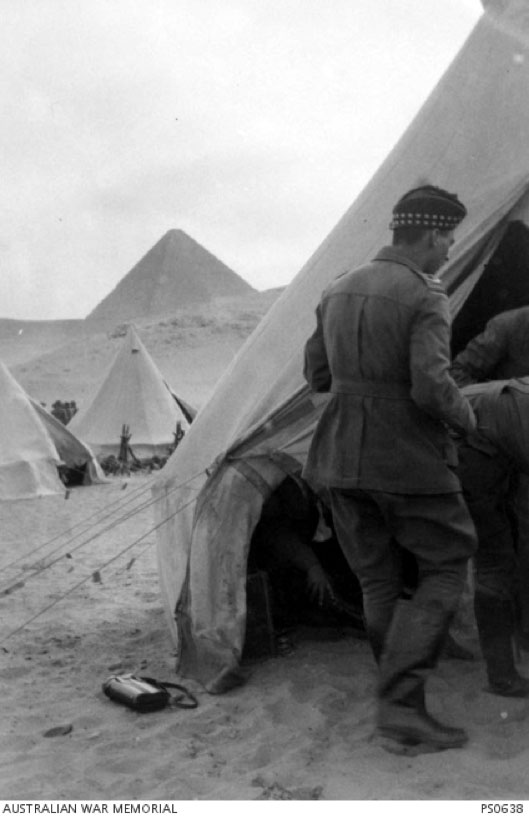
This photograph is identified as ‘possibly’ Captain Bert Flockart at Giza, Egypt in about October 1914
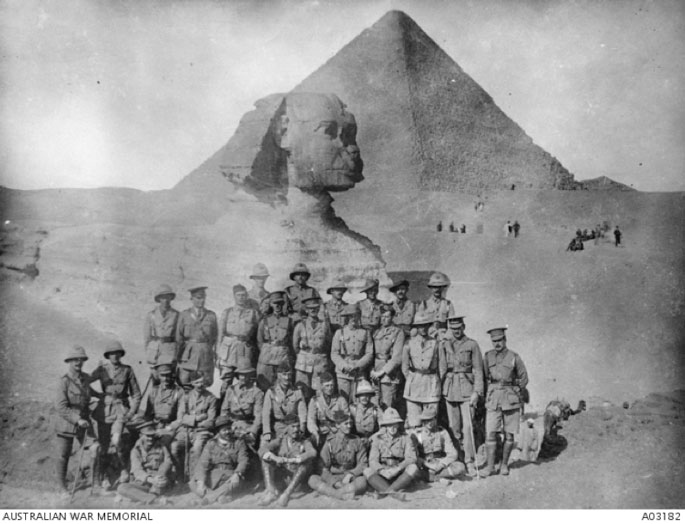
Bert Flockart (then a captain) is at far left in the third row from the front here with other officers of the 5th Battalion at Giza, Egypt, in 1915. Bert’s friend Erle Fethers is fourth from the left in the second row, sitting with his arms crossed.
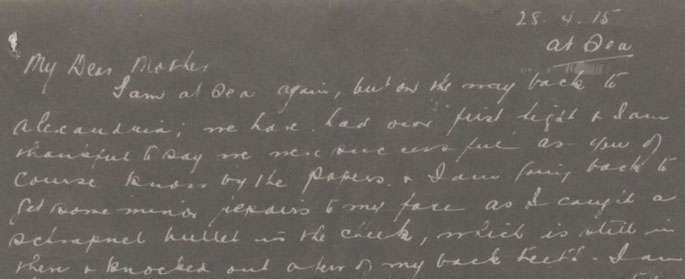
Extract from Bert Flockart’s letter of 28 April 1915 (AWM 1DRL/0296)
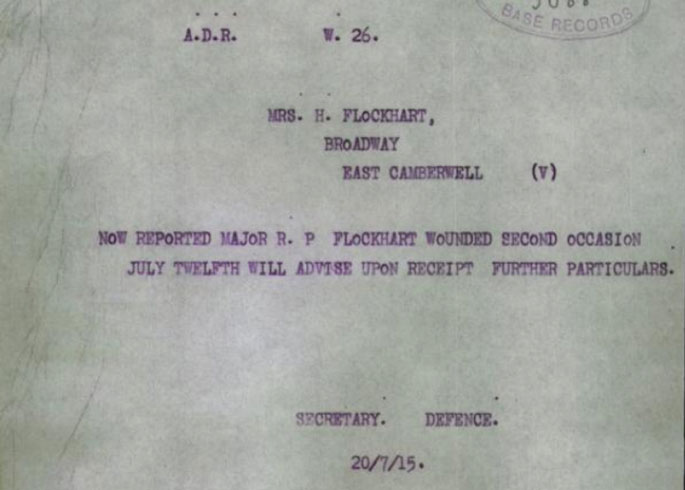
From Bert Flockart’s service record
Sources:
- Australian War Memorial – Roll of Honour and AWM 1DRL/0296, which contains 12 letters that Flockart sent to his mother from 16 April to 9 July 1915. These letters can be downloaded here: http://www.awm.gov.au/collection/RCDIG0000247/
- Bean, C.E.W., Official History of Australia in the War of 1914–1918:
- Vol. I: The Story of ANZAC from the Outbreak of War to the End of the First Phase of the Gallipoli Campaign, May 4, 1915, Angus & Robertson, Sydney, 1941
- Vol. II:The Story of ANZAC from 4 May, 1915, to the Evacuation of the Gallipoli Peninsula,
- Angus & Robertson, Sydney, 1941
- Mishura Scotch Database
- National Archives of Australia – B2455, FLOCKART R P
- Scotch Collegian 1915 and 1923
- The AIF Project - https://www.aif.adfa.edu.au/showPerson?pid=99869 and File on Erle Finlayson Denton FETHERS